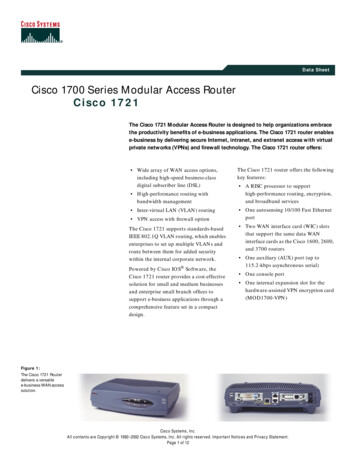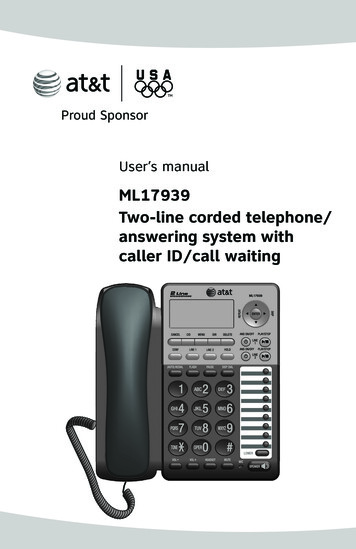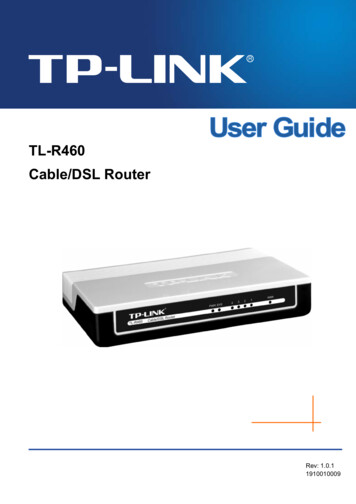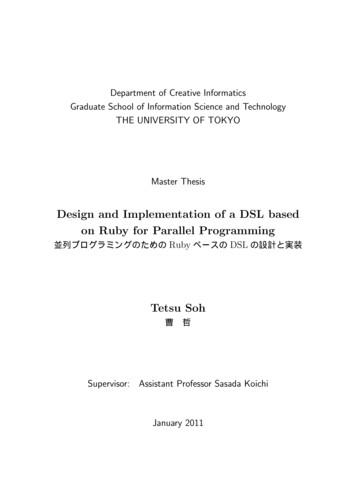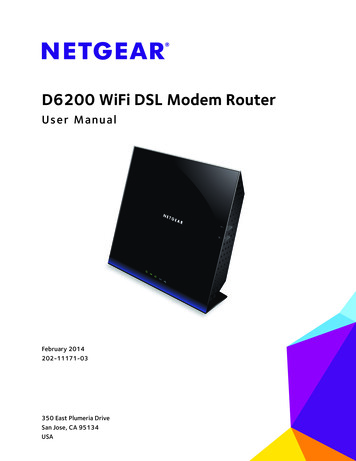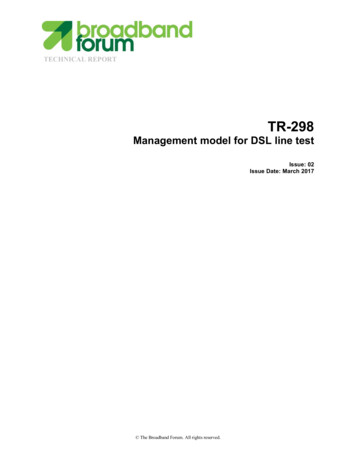
Transcription
TECHNICAL REPORTTR-298Management model for DSL line testIssue: 02Issue Date: March 2017 The Broadband Forum. All rights reserved.
Management model for DSL line testTR-298 Issue 02NoticeThe Broadband Forum is a non-profit corporation organized to create guidelines for broadbandnetwork system development and deployment. This Technical Report has been approved bymembers of the Forum. This Technical Report is subject to change. This Technical Report iscopyrighted by the Broadband Forum, and all rights are reserved. Portions of this TechnicalReport may be copyrighted by Broadband Forum members.Intellectual PropertyRecipients of this Technical Report are requested to submit, with their comments, notification ofany relevant patent claims or other intellectual property rights of which they may be aware thatmight be infringed by any implementation of this Technical Report, or use of any software codenormatively referenced in this Technical Report, and to provide supporting documentation.Terms of Use1. LicenseBroadband Forum hereby grants you the right, without charge, on a perpetual, non-exclusive andworldwide basis, to utilize the Technical Report for the purpose of developing, making, havingmade, using, marketing, importing, offering to sell or license, and selling or licensing, and tootherwise distribute, products complying with the Technical Report, in all cases subject to theconditions set forth in this notice and any relevant patent and other intellectual property rights ofthird parties (which may include members of Broadband Forum). This license grant does notinclude the right to sublicense, modify or create derivative works based upon the Technical Reportexcept to the extent this Technical Report includes text implementable in computer code, in whichcase your right under this License to create and modify derivative works is limited to modifyingand creating derivative works of such code. For the avoidance of doubt, except as qualified by thepreceding sentence, products implementing this Technical Report are not deemed to be derivativeworks of the Technical Report.2. NO WARRANTIESTHIS TECHNICAL REPORT IS BEING OFFERED WITHOUT ANY WARRANTYWHATSOEVER, AND IN PARTICULAR, ANY WARRANTY OF NONINFRINGEMENT ISEXPRESSLY DISCLAIMED. ANY USE OF THIS TECHNICAL REPORT SHALL BE MADEENTIRELY AT THE IMPLEMENTER'S OWN RISK, AND NEITHER THE BROADBANDFORUM, NOR ANY OF ITS MEMBERS OR SUBMITTERS, SHALL HAVE ANY LIABILITYWHATSOEVER TO ANY IMPLEMENTER OR THIRD PARTY FOR ANY DAMAGES OFANY NATURE WHATSOEVER, DIRECTLY OR INDIRECTLY, ARISING FROM THE USEOF THIS TECHNICAL REPORT.3. THIRD PARTY RIGHTSWithout limiting the generality of Section 2 above, BROADBAND FORUM ASSUMES NORESPONSIBILITY TO COMPILE, CONFIRM, UPDATE OR MAKE PUBLIC ANY THIRDPARTY ASSERTIONS OF PATENT OR OTHER INTELLECTUAL PROPERTY RIGHTSTHAT MIGHT NOW OR IN THE FUTURE BE INFRINGED BY AN IMPLEMENTATION OFTHE TECHNICAL REPORT IN ITS CURRENT, OR IN ANY FUTURE FORM. IF ANY SUCHMarch 2017 The Broadband Forum. All rights reserved2 of 21
Management model for DSL line testTR-298 Issue 02RIGHTS ARE DESCRIBED ON THE TECHNICAL REPORT, BROADBAND FORUM TAKESNO POSITION AS TO THE VALIDITY OR INVALIDITY OF SUCH ASSERTIONS, ORTHAT ALL SUCH ASSERTIONS THAT HAVE OR MAY BE MADE ARE SO LISTED.The text of this notice must be included in all copies of this Technical Report.March 2017 The Broadband Forum. All rights reserved3 of 21
Management model for DSL line testTR-298 Issue 02Issue HistoryIssue Number1Approval Date27 June 2013Publication Date213 March 20171 May 2017Issue EditorDaniel CederholmEricssonJoey Boyd,ADTRANChangesOriginalEdited to alignwith TR-355Comments or questions about this Broadband Forum Technical Report should be directed tohelp@broadband-forum.org.EditorsJoey BoydADTRANjoey.boyd@adtran.comFTTdp Work AreaDirectorsChristopher CrootBT plcchris.croot@bt.comSven OogheNokiasven.ooghe@nokia.comMarch 2017 The Broadband Forum. All rights reserved4 of 21
Management model for DSL line testTR-298 Issue 02TABLE OF CONTENTSEXECUTIVE SUMMARY . 71PURPOSE AND SCOPE . 81.11.22REFERENCES AND TERMINOLOGY . 92.12.22.33PURPOSE . 8SCOPE . 8CONVENTIONS . 9REFERENCES . 9ABBREVIATIONS . 10TECHNICAL REPORT IMPACT . 113.13.23.33.4ENERGY EFFICIENCY. 11IPV6 . 11SECURITY. 11PRIVACY . 114OBJECT MODEL FOR DSL LINE TEST . 125OBJECT MODEL FOR SINGLE ENDED LINE TEST (SELT) . 135.1SELT CONFIGURATION MODEL . 135.1.1 SELT Configuration Vector . 145.2SELT RESULT PARAMETER MODEL . 156OBJECT MODEL FOR DUAL ENDED LINE TEST (DELT) . 167OBJECT MODEL FOR METALLIC LINE TEST (MELT) . 167.1MELT CONFIGURATION MODEL . 167.1.1 MELT Configuration Vector . 177.2MELT RESULT PARAMETER MODEL . 18March 2017 The Broadband Forum. All rights reserved5 of 21
Management model for DSL line testTR-298 Issue 02List of FiguresFigure 1: Functional reference model of DSL line test. 12Figure 2: Notations . 13Figure 3: SELT configuration model . 14Figure 4: SELT result parameter model. 15Figure 5: MELT configuration model. 16Figure 6: MELT result parameter model . 19March 2017 The Broadband Forum. All rights reserved6 of 21
Management model for DSL line testTR-298 Issue 02Executive SummaryThis Technical Report specifies a management model for DSL line tests containing the parametersdescribed in ITU-T Recommendation G.996.2 [2].March 2017 The Broadband Forum. All rights reserved7 of 21
Management model for DSL line test1TR-298 Issue 02Purpose and Scope1.1 PurposeThe purpose of this Technical Report is to provide a management model for ITU-TRecommendation G.996.2 [2] and its Amendment 2 [3]. The management model is independent ofany protocol.1.2 ScopeThis Technical Report defines an object model for all the DSL line test parameters specified inG.996.2. The object model specifies the structure of the managed objects, and the detailedspecifications of the parameters are given in G.996.2.March 2017 The Broadband Forum. All rights reserved8 of 21
Management model for DSL line test2TR-298 Issue 02References and Terminology2.1 ConventionsIn this Technical Report, several words are used to signify the requirements of the specification.These words are always capitalized. More information can be found be in RFC 2119 [1].MUSTThis word, or the term “REQUIRED”, means that the definition is anabsolute requirement of the specification.MUST NOTThis phrase means that the definition is an absolute prohibition of thespecification.SHOULDThis word, or the term “RECOMMENDED”, means that there couldexist valid reasons in particular circumstances to ignore this item, butthe full implications need to be understood and carefully weighedbefore choosing a different course.SHOULD NOT This phrase, or the phrase "NOT RECOMMENDED" means that therecould exist valid reasons in particular circumstances when theparticular behavior is acceptable or even useful, but the fullimplications need to be understood and the case carefully weighedbefore implementing any behavior described with this label.This word, or the term “OPTIONAL”, means that this item is one ofan allowed set of alternatives. An implementation that does notinclude this option MUST be prepared to inter-operate with anotherimplementation that does include the option.MAY2.2 ReferencesThe following references are of relevance to this Technical Report. At the time of publication, theeditions indicated were valid. All references are subject to revision; users of this Technical Reportare therefore encouraged to investigate the possibility of applying the most recent edition of thereferences listed below.A list of currently valid Broadband Forum Technical Reports is published 1]RFC 2119Key words for use in RFCs to IndicateRequirement LevelsIETF1997[2]G.996.2Single-ended line testing for digitalsubscriber lines (DSL)ITU-T2009[3]G.996.2Single-ended line testing for digitalITU-T2012March 2017 The Broadband Forum. All rights reserved9 of 21
Management model for DSL line test[4]Amendment 2subscriber lines (DSL) Amendment 2TR-252 Issue2xDSL Protocol-IndependentManagement ModelTR-298 Issue 02BBF20122.3 AbbreviationsThis Technical Report uses the following TSCVTGTRUERUSMarch 2017Alternating CurrentDirect CurrentDual Ended Line TestDownstreamFar-EndForeign VoltageManagement EntityMetallic Line TestMaximum Measurement DurationPhysical Medium DependentQuiet Line NoiseRing to GroundRing to TipSingle Ended Line TestSignature Conduction VoltageTip to GroundTip to RingUncalibrated Echo ResponseUpstream The Broadband Forum. All rights reserved10 of 21
Management model for DSL line test3TR-298 Issue 02Technical Report Impact3.1 Energy EfficiencyTR-298 has no impact on energy efficiency.3.2 IPv6TR-298 has no impact on IPv6.3.3 SecurityTR-298 has no impact on security.3.4 PrivacyAny issues regarding privacy are not affected by TR-298.March 2017 The Broadband Forum. All rights reserved11 of 21
Management model for DSL line test4TR-298 Issue 02Object model for DSL line testThis specification is based on the parameters listed in G.996.2 and its Amendment 2. The objectmodel in this specification specifies the structure of the managed objects, and the detailedparameter definitions and their access mode (read-only vs read-write) are specified in G.996.2.Figure 1 shows the line test functional reference model defined in G.996.2. This model definesseveral functional blocks representing different line test functions. There are two main categoriesof functions; processing (P) and Physical Medium Dependent (PMD). The PMD functions arerelated to measurements on the physical medium while the P functions are related to the processingand transformation of the PMD results into derived parameters.ACSOSSQ interface G interface C ref pointLT-ME-P - C R ref pointLT -P - CLT-ME-P - RLT- P - RMIBMIB R ref point C ref pointLT -ME-PMD - CT interfaceLineUnderTestLT- PMD - CMIB C ref pointU-CLT- PMD - RLT-ME-PMD - RMIBU-R R ref pointFigure 1: Functional reference model of DSL line testNote that the functional reference model in G.996.2 defines three different interfaces (Q, T and G)and that each object in this specification is only available over some of these interfaces. Theparameters supported by each interface are listed in G.996.2 and will not be further discussed inthis Technical Report. It should also be noted that this Technical Report specifies full data models,including all relevant standard configuration and status parameters. However, some of thosestandard parameters are originally specified (e.g. G.996.2) as optional. While the structure andcontent of the data models are mandatory, in practice an implementation might not support anyparticular optional parameter. If the implementation does not support any optional parameter itshould still respond appropriately to read-write operations addressing it (e.g. by an error-code, byreturning a NULL value, etc.). The response type is beyond the scope of this Technical Report andmainly depends on the specific management protocol being used.The model uses the principle of Vector of Profiles (VoP) defined in Broadband Forum TR-252 [4].This means that the configuration parameters are divided into independent profiles and that themodel uses pointers to these profiles.Figure 2 illustrates notations used in this specification for illustrating the object model.March 2017 The Broadband Forum. All rights reserved12 of 21
Management model for DSL line testATR-298 Issue 02xy‘x’ instances of object A are logically related to ‘y’ instances ofobject B. This may represent indirect relationship through otherobjects.1Object A contains ‘y’ instances of object B.BAyBAObject A is a super-class with B and C as sub-classes(inheritance relationship).BCAxyBN N.MObject A contains pointers to ‘y’ instances of Object B.Each instance of Object B is pointed to by ‘x’ instances of ObjectA.: N or more instances: N to M instancesFigure 2: Notations5Object model for Single Ended Line Test (SELT)The object model for SELT is divided into two submodels; One contains the configuration andcontrol parameters and one contains the result (measurement and derived) parameters.5.1 SELT configuration modelThe SELT configuration model includes all configuration related parameters from G.996.2 andalso the SELT-PMD control parameters used for triggering tests. The model is shown inFigure 3.The parameter names are taken from G.996.2 and its amendments which give the parameterdefinitions. The supported types of measurements are Quiet Line Noise (QLN) and UncalibratedEcho Response (UER).March 2017 The Broadband Forum. All rights reserved13 of 21
Management model for DSL line testTR-298 Issue 02xDSL Line1111SELT-PMDControlSELT Configuration Vector1111SELT-PMDProfileSELT-PProfileFigure 3: SELT configuration modelThe xDSL Line object represents an individual physical transmission line in a similar way asdefined in TR-252.The following attributes MUST be supported by the xDSL Line object: Pointer to SELT Configuration VectorThe following attributes MUST be supported by the SELT-PMD Control object: SELT UER measurement enable C (SELT-UME-C)SELT UER measurement enable R (SELT-UME-R)SELT QLN measurement enable C (SELT-QME-C)SELT QLN measurement enable R (SELT-QME-R)5.1.1 SELT Configuration VectorThe SELT Configuration Vector object represents a SELT configuration by referring to one profilefor each of the functional blocks SELT-PMD and SELT-P in the G.996.2 functional referencemodel.The SELT Configuration Vector MUST contain the following parameters: Pointer to SELT-PMD ProfilePointer to SELT-P Profile5.1.1.1 SELT-PMD ProfileThe SELT-PMD Profile contains the parameters for configuration of the SELT-PMD. The SELTPMD performs measurements on the physical medium the device is connected to.The SELT-PMD Profile MUST contain the following parameters:March 2017 The Broadband Forum. All rights reserved14 of 21
Management model for DSL line test TR-298 Issue 02SELT UER maximum measurement duration C (SELT UER MMD C)SELT UER maximum measurement duration R (SELT UER MMD R)SELT quiet line noise maximum measurement duration C (SELT QLN MMD C)SELT quiet line noise maximum measurement duration R (SELT QLN MMD R)5.1.1.2 SELT-P ProfileThe SELT-P Profile contains the parameters for configuration of the SELT-P (Processing). TheSELT-P processes the results from SELT-PMD measurements and transforms them into derivedparameters representing the characteristics of the loop under test. The configuration parameters arerelated to estimation of the achievable capacity on the loop.The SELT-P Profile MUST contain the following parameters: Capacity estimate calculation enabling (CECE)Capacity estimate signal PSD downstream (CAP-SIGNALPSDds)Capacity estimate signal PSD upstream (CAP-SIGNALPSDus)Capacity estimate noise PSD downstream (CAP-NOISEPSDds)Capacity estimate noise PSD upstream (CAP-NOISEPSDus)Capacity estimate target noise margin downstream (CAP-TARSNRMds)Capacity estimate target noise margin upstream (CAP-TARSNRMus)5.2 SELT result parameter modelThe SELT result parameter object represents all the results related to the SELT process. It containstwo sub-classes; one for the measured parameters in SELT-PDM and one for the derivedparameters in SELT-P.The SELT result parameter model is illustrated in Figure 4.xDSL Line1111SELT-PMDMeasurement parametersSELT-PDerived parametersFigure 4: SELT result parameter modelThe SELT result parameter model MUST contain the following SELT-PMD measurementparameters:March 2017 The Broadband Forum. All rights reserved15 of 21
Management model for DSL line test TR-298 Issue 02SELT uncalibrated echo response C (SELT-UER-C)SELT uncalibrated echo response R (SELT-UER-R)SELT variance of uncalibrated echo response C (SELT-UER-VAR-C)SELT variance of uncalibrated echo response R (SELT-UER-VAR-R)SELT quiet line noise C (SELT QLN C)SELT quiet line noise R (SELT QLN R)The SELT result parameter model MUST contain the following SELT-P derived parameters: 6Loop termination indicator (LOOP-TERM)Loop length (LOOP LEN)Loop topology (LOOP-TOPOLOGY)Attenuation characteristics TFlog(f) (ATT-CHAR)Missing micro-filter or splitter (MIS-FILTER)Capacity estimate (CAP-EST)Object model for Dual Ended Line Test (DELT)DELT is currently for further study in G.996.2 and is thus for further study in this TechnicalReport.7Object model for Metallic Line Test (MELT)The object model for MELT is divided into two submodels; one contains the configuration andcontrol parameters and one contains the result (measurement and derived) parameters.7.1 MELT configuration modelThe MELT configuration model includes all configuration related parameters and also the MELTPMD control parameters used for triggering tests. The model is shown in Figure 5.The parameter names are taken from G.996.2 and its amendments which give the parameterdefinitions.xDSL Line1111MELT-PMDControlMELT Configuration Vector1111MELT-PMDProfileMELT-PProfileFigure 5: MELT configuration modelMarch 2017 The Broadband Forum. All rights reserved16 of 21
Management model for DSL line testTR-298 Issue 02The xDSL Line object represents an individual physical transmission line in a similar way asdefined in TR-252.The following attributes MUST be supported by the xDSL Line object: Pointer to MELT Configuration VectorThe following attributes MUST be supported by the MELT-PMD Control object: MELT measurement enableMELT pair identification tone generation7.1.1 MELT Configuration VectorThe MELT Configuration Vector object represents a MELT configuration by referring to oneprofile for each of the functional blocks MELT-PMD and MELT-P in the G.996.2 functionalreference model.The MELT Configuration Vector MUST contain the following parameters: Pointer to MELT-PMD ProfilePointer to MELT-P Profile7.1.1.1 MELT-PMD ProfileThe MELT-PMD Profile contains the parameters for configuration of the MELT-PMD. TheMELT-PMD performs measurements on the physical medium the device is connected to.The MELT-PMD Profile MUST contain the following parameters: Peak metallic voltage between tip and ring (MELT-PV)Pair identification tone frequency (MELT-PIT-F)Maximum far-end signature conduction voltage (MELT-MAXFE-SCV)Minimum far-end signature conduction voltage (MELT-MINFE-SCV)Measurement class (MELT-MCLASS)Signal frequency for active AC tests (MELT-AC-F)The supported types of measurements specified by the measurement class (MELT-MCLASS) are: Measurement of the 4-element DC resistance with a controlled metallic voltage Measurement of the 3-element capacitance with a controlled metallic voltage Measurement of foreign DC voltage Measurement of foreign AC voltage Measurement of the loop capacitance with a high metallic voltage Measurement of the loop resistance with a high metallic voltageMarch 2017 The Broadband Forum. All rights reserved17 of 21
Management model for DSL line test TR-298 Issue 02Measurement of the 3-element complex admittances with a controlled metallic voltageMeasurement of the loop complex admittance with a high metallic voltage7.1.1.2 MELT-P ProfileThe MELT-P Profile contains the parameters for configuration of the MELT-P (Processing). TheMELT-P processes the results from MELT-PMD measurements and transforms them into derivedparameters representing the characteristics of the loop under test. The supported types of MELT-Pderived parameters are: Identification of an open wire failureOpen wire failure typeDistance to the open wire failureIdentification of a short circuit failureShort circuit failure typeLeakage identificationResistive fault identificationForeign voltage classificationForeign voltage typeForeign voltage level classFar-end signature topology identificationFar-end signature topology typeThe MELT-P Profile MUST contain the following parameters: Loop resistance classification threshold (MELT-LRC-TH)Loop parameters per unit length (MELT-LOOP-PARAMS)Hazardous DC voltage level (MELT-HDCV-L)Hazardous AC voltage level (MELT-HACV-L)Foreign EMF DC voltage level (MELT-FDCV-L)Foreign EMF AC voltage level (MELT-FACV-L)System capacitance at the CPE side (MELT-SYSC-CPE)7.2MELT result parameter modelThe MELT result parameter object represents all the results related to the MELT test. It containstwo sub-classes; one for the measured parameters in MELT-PMD and one for the derivedparameters in MELT-P.The MELT result parameter model is illustrated in Figure 6.March 2017 The Broadband Forum. All rights reserved18 of 21
Management model for DSL line testTR-298 Issue 02xDSL Line1111MELT-PMDMeasurement parametersMELT-PDerived parametersFigure 6: MELT result parameter modelThe MELT result parameter model MUST contain the following MELT-PMD reportingparameters: Measurement frequency for active AC tests (MELT-MFREQ)Input impedance for foreign voltage measurements (MELT-IMP-V)Measurement voltage for loop complex admittance with a high voltage test (MELT-HCA-V)The MELT result parameter model MUST contain the following MELT-PMD measurementparameters: 4-element DC resistance with controlled metallic voltage RTR (MELT-CDCR-TR)4-element DC resistance with controlled metallic voltage RRT (MELT-CDCR-RT)4-element DC resistance with controlled metallic voltage RTG (MELT-CDCR-TG)4-element DC resistance with controlled metallic voltage RRG (MELT-CDCRRG)3-element capacitance with controlled metallic voltage CTR (MELT-CC-TR)3-element capacitance with controlled metallic voltage CTG (MELT-CC-TG)3-element capacitance with controlled metallic voltage CRG (MELT-CC-RG)Foreign DC voltage VTR,DC (MELT-FVDC-TR)Foreign DC voltage VTG,DC (MELT-FVDC-TG)Foreign DC voltage VRG,DC (MELT-FVDC-RG)Foreign AC voltage VTR,AC (MELT-FVAC-TR)Foreign AC voltage VTG,AC (MELT-FVAC-TG)Foreign AC voltage VRG,AC (MELT-FVAC-RG)Foreign AC voltage frequency FTR,AC (MELT-FVACF-TR)Foreign AC voltage frequency FTG,AC (MELT-FVACF-TG)Foreign AC voltage frequency FRG,AC (MELT-FVACF-RG)Loop capacitance with high metallic voltage CTR,HV (MELT-HC-TR)Loop resistance with high metallic voltage RTR,HV (MELT-HDCR-TR)Loop resistance with high metallic voltage RRT,HV (MELT-HDCR-RT)DC test voltage for the measurement of the 4-element DC resistance with a controlled metallicvoltage VDCTR (MELT-CDCV-TR)DC test voltage for the measurement of the 4-element DC resistance with a controlled metallicvoltage VDCRT (MELT-CDCV-RT)DC test voltage for the measurement of the 4-element DC resistance with a controlled metallicvoltage VDCTG (MELT-CDCV-TG)March 2017 The Broadband Forum. All rights reserved19 of 21
Management model for DSL line test TR-298 Issue 02DC test voltage for the measurement of the 4-element DC resistance with a controlled metallicvoltage VDCRG (MELT-CDCV-RG)Test current for the 4-element DC resistance with a controlled metallic voltage IDCTR(MELT-CDCI-TR)Test current for the 4-element DC resistance with a controlled metallic voltage IDCRT(MELT-CDCI-RT)Test current for the 4-element DC resistance with a controlled metallic voltage IDCTG(MELT-CDCI-TG)Test current for the 4-element DC resistance with a controlled metallic voltage IDCRG(MELT-CDCI-RG)Test voltage for the measurement of the loop resistance with a high metallic voltage VDCHTR(MELT-HDCV-TR)Test voltage for the measurement of the loop resistance with a high metallic voltage VDCHRT(MELT-HDCV-RT)Measurement voltage VACTR-CC (MELT-ACV-CC-TR)Measurement voltage VACTG-CC (MELT-ACV-CC-TG)Measurement voltage VACRG-CC (MELT-ACV-CC-RG)Measurement voltage VACTR-HC (MELT-ACV-HC-TR)Measurement voltage VACTR-CA (MELT-ACV-CA-TR)Measurement voltage VACTG-CA (MELT-ACV-CA-TG)Measurement voltage VACRG-CA (MELT-ACV-CA-RG)Measurement voltage VACTR-HA (MELT-ACV-HA-TR)3-element complex admittance with controlled metallic voltage real part GTR (MELT-CAGTR)3-element complex admittance with controlled metallic voltage imaginary part BTR (MELTCAB-TR)3-element complex admittance with controlled metallic voltage real part GTG (MELT-CAGTG)3-element complex admittance with controlled metallic voltage imaginary part BTG (MELTCAB-TG)3-element complex admittance with controlled metallic voltage real part GRG (MELT-CAGRG)3-element complex admittance with controlled metallic voltage imaginary part BRG (MELTCAB-RG)Loop complex admittance with high metallic voltage real part GTR,HV (MELTHAG-TR)Loop complex admittance with high metallic voltage imaginary part BTR,HV (MELT-HABTR)The MELT result parameter model MUST contain the following MELT-P derived parameters: Identification of an open wire failure (MELT-O-WIRE-type) – Open wire failure TypeIdentification of an open wire failure (MELT-O-WIRE-DIST) – Distance to the open wirefailureIdentification of a short circuit failure type (MELT-S-CCT-type)Leakage identification (MELT-LEAK-ID)March 2017 The Broadband Forum. All rights reserved20 of 21
Management model for DSL line test TR-298 Issue 02Resistive fault identification (MELT-RFAULT-ID)Foreign voltage type classification (MELT-FV-TYPE)Foreign voltage level classification (MELT-FV-LEVEL)Far-end signature topology type identification (MELT-FES-ID)End of Broadband Forum Technical Report TR-298March 2017 The Broadband Forum. All rights reserved21 of 21
include the right to sublicense, modify or create derivative works based upon the Technical Report except to the extent this Technical Report includes text implementable in computer code, in which case your right under this License to create and modify derivative works is limited to modifying and creating derivative works of such code.
